Phyllis:
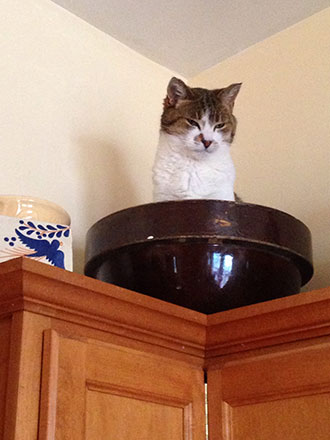
*Even though kindle means cats born in the same litter, the alliteration was hard to resist.
“All my work is done in the company of cats,” writes Nicola Bayley, wonderful picture book artist and writer, in her book The Necessary Cat.
I know what she means. Right now my cat Luna is sitting on the open copy of The Kittens’ ABC, clearly a cat of discerning literary taste.
Cats and writers seem to have a particular relationship. Cats wander in and out of our picture books, take naps on our keyboards, and curl up in our hearts. This month we looked at a few of the many picture books where cats play a role.
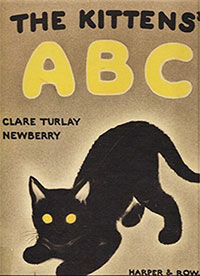 I was introduced to Claire Turlay Newberry when I found a used copy of The Kittens’ ABC and was enchanted by her drawings of cats in which she captures them with a few lines in charcoal, pencil, and pastels. (Of her seventeen picture books, all but three are about cats.) The rhymes with each letter of this ABC are simple, but I could linger over those wise, playful, cozy pictures for hours. And if Luna has her way, curled up now on N is for Nap, I will.
I was introduced to Claire Turlay Newberry when I found a used copy of The Kittens’ ABC and was enchanted by her drawings of cats in which she captures them with a few lines in charcoal, pencil, and pastels. (Of her seventeen picture books, all but three are about cats.) The rhymes with each letter of this ABC are simple, but I could linger over those wise, playful, cozy pictures for hours. And if Luna has her way, curled up now on N is for Nap, I will.
Kittens like to take their naps
In boxes, bureau drawers, and laps;
Or else, along the sofa pillows,
In rows, like little pussywillows.
 Another used book find is Green Eyes by A. Birnbaum, winner of a 1953 Caldecott honor. The story follows the first year of a springtime-born kitten’s life, from scrambling out of a large box to exploring the farm life around him — chickens, cows, pigs, goats. By the time leaves fall, followed by snow, the now almost grown cat fits more snugly in his box. The art is superb, strong black lines and bright colors. This is the only picture book Birnbaum both wrote and also illustrated, but his work appeared on The New Yorker covers over more than forty years. Scrolling through images of those covers, I found myself wishing he had illustrated a whole stack of picture books (two of my favorite images: the woodpecker rattling away after a bug to feed the nest of little woodpeckers and the exuberant crocus in a pot).
Another used book find is Green Eyes by A. Birnbaum, winner of a 1953 Caldecott honor. The story follows the first year of a springtime-born kitten’s life, from scrambling out of a large box to exploring the farm life around him — chickens, cows, pigs, goats. By the time leaves fall, followed by snow, the now almost grown cat fits more snugly in his box. The art is superb, strong black lines and bright colors. This is the only picture book Birnbaum both wrote and also illustrated, but his work appeared on The New Yorker covers over more than forty years. Scrolling through images of those covers, I found myself wishing he had illustrated a whole stack of picture books (two of my favorite images: the woodpecker rattling away after a bug to feed the nest of little woodpeckers and the exuberant crocus in a pot).
It’s hard for YouTube to do justice to the art, but you can see and hear Green Eyes, now reissued.
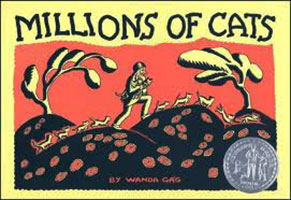 Millions of Cats, written and illustrated by Wanda Gag, with double page spreads, black and white lithograph prints, and hand lettered text has been called the first true American picture book. Millions of Cats won a Newbery honor in 1929 (the Caldecott did not yet exist) and has been in print ever since. The text and art roll rhythmically through the story, and the smallest cat, who didn’t consider herself pretty enough to argue with the other cats about who was prettiest, is the only one left after the hundreds of cats, thousands of cats, millions and billions and trillions of cats fight so much they eat each other up. The littlest kitten, adopted and loved by the little old lady and the little old man (cat owners might say the people were adopted by the kitten) becomes the prettiest cat of all.
Millions of Cats, written and illustrated by Wanda Gag, with double page spreads, black and white lithograph prints, and hand lettered text has been called the first true American picture book. Millions of Cats won a Newbery honor in 1929 (the Caldecott did not yet exist) and has been in print ever since. The text and art roll rhythmically through the story, and the smallest cat, who didn’t consider herself pretty enough to argue with the other cats about who was prettiest, is the only one left after the hundreds of cats, thousands of cats, millions and billions and trillions of cats fight so much they eat each other up. The littlest kitten, adopted and loved by the little old lady and the little old man (cat owners might say the people were adopted by the kitten) becomes the prettiest cat of all.
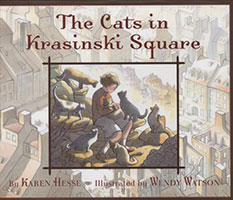 Cats are the heroes in The Cats in Krasnski Square by Karen Hesse, a fictional story based on a true story of cats helping outwit the Gestapo and smuggle food into the Warsaw ghetto during World War II.
Cats are the heroes in The Cats in Krasnski Square by Karen Hesse, a fictional story based on a true story of cats helping outwit the Gestapo and smuggle food into the Warsaw ghetto during World War II.
The cats
come
from the cracks in the Wall,
the dark corners,
the openings in the rubble
With her older sister (all that is left of her family) the narrator, who escaped the Polish ghetto and now lives outside its walls, is part of the resistance smuggling food to Jews still imprisoned inside the ghetto, including her friend Michael. When the resistance learns that the Gestapo is coming with dogs on leashes to sniff out the food arriving by train to be smuggled behind the walls, the narrator knows what to do: round up as many cats as possible and take them to the station. As the train arrives, the narrator and her friends release the cats, which drives the dogs wild; during the distraction the food vanishes from the station
through the Wall, over the Wall, under the Wall,
into the Ghetto.
Wendy Watson, one of my favorite artists, illustrated the books in somber tones reflecting the gravity of the story, where acts of great courage can resist great darkness.
So many more cat books to love! Here are a few to check out:
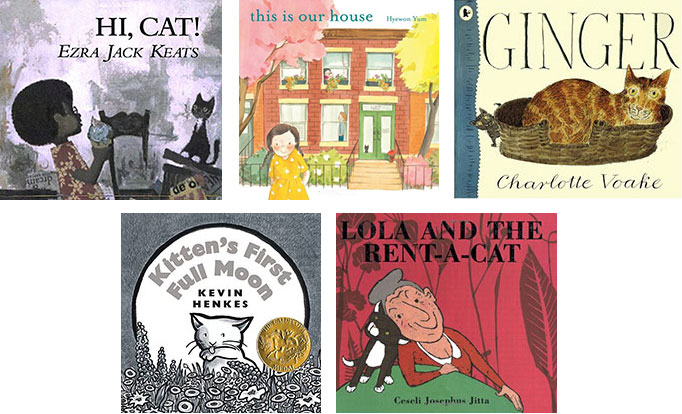
All Archie says to the stray cat on the city sidewalk is, “Hi, Cat!” in Hi, Cat! by Ezra Jack Keats, but the cat follows him and manages to ruin every act of the show Archie and his friend Peter are putting on. Still, Archie decides that the cat “just kinda liked me!”
Cats aren’t mentioned in This is Our House by Hyewon Yum, but generations of cats and kittens weave in and out of the art of this deceptively simple story of immigration, family, and home.
Ginger written and illustrated by Charlotte Voake, is a tale of “sibling” rivalry when the cat of the house must deal with a new kitten.
Kitten’s First Full Moon by Kevin Henkes tells of a kitten who thinks the first full moon of her life is a bowl of milk in the sky, but all her efforts to drink that milk end in disaster. Luckily, when she returns home, a bowl of milk is waiting just for her.
Lola and the Rent-a-Cat, written and illustrated by Ceseli Josephus Jitta, tells how Lola, whose husband of many years has died, finds a cat to belong to (and keep) through the Internet. Lola chooses number 313 Tim:
- Homely, slightly older cat
- Loves attention and care
- Fond of diet food
Lola and Tim are together all the time, and she is able to recall the good memories as she and Tim sit on a bench in the evenings, and Tim purrs as she strokes him.
October 29 is National Cat Day, but any day is a good day to curl up with a cat book (and a cat, if one is handy).
